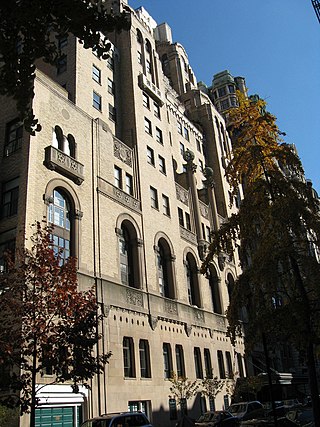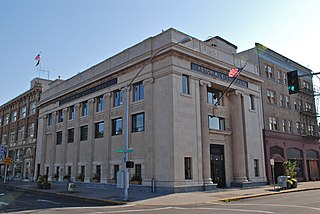
El Capitan Theatre is a fully restored movie palace at 6838 Hollywood Boulevard in the Hollywood neighborhood in Los Angeles, California, United States. The theater and adjacent Hollywood Masonic Temple are owned by The Walt Disney Company and serve as the venue for a majority of the Walt Disney Studios' film premieres.

The California State Capitol is the seat of the California state government, located in Sacramento, the state capital of California. The building houses the chambers of the California State Legislature, made up of the Assembly and the Senate, along with the office of the governor of California. The Neoclassical structure, designed by Reuben S. Clark, was completed between 1861 and 1874. Located at the west end of Capitol Park and the east end of the Capitol Mall, the building was added to the National Register of Historic Places in 1973. The California State Capitol Museum is housed on the grounds of the capitol.

The Sunshine Building is a historic six-story building in downtown Albuquerque, New Mexico. It was built in 1924 by local theater owner Joseph Barnett and houses the Sunshine Theater as well as commercial space and offices. The Sunshine operated primarily as a movie theater until the 1980s, though it was also equipped for Vaudeville shows and other live performances. Since 1990 it has operated as a live music venue, hosting many notable acts. The building was listed on the New Mexico State Register of Cultural Properties in 1985 and is also an Albuquerque City Landmark.

The Midland Theatre is a 3,000-seat theater located in the Power & Light District of Kansas City, Missouri, United States. The National Collegiate Athletic Association under Walter Byers had its headquarters in the building from the 1950s until it moved to 6299 Nall Avenue at Shawnee Mission Parkway in Mission, Kansas in 1971. The theatre was originally known as the Loew's Midland Theatre until 1961. Over the years, the theatre has been known by various names including: Saxon Theatre, Midland Stadium, Midland 1-2-3 Theatre, Midland Theatre and The Midland by AMC, and Arvest Bank Theatre at The Midland.

The Rialto Theatre is a performance theater and concert venue located on Congress Street in downtown Tucson, Pima County, southern Arizona. The cinema−theater and surrounding Rialto Building commercial block were listed on the National Register of Historic Places in 2003.

The Bagdad Theatre is a movie theater in the Hawthorne District of Portland, Oregon, United States. It originally opened in 1927 and was the site of the gala premiere of One Flew Over the Cuckoo's Nest in 1975, and of My Own Private Idaho in 1991.
The 1918 San Fermín earthquake, also known as the Puerto Rico earthquake of 1918, struck the island of Puerto Rico at on October 11. The earthquake measured 7.1 on the moment magnitude scale and IX (Violent) on the Mercalli intensity scale. The mainshock epicenter occurred off the northwestern coast of the island, somewhere along the Puerto Rico Trench.

The ten-story Fine Arts Building, formerly known as the Studebaker Building, is located at 410 S Michigan Avenue across from Grant Park in Chicago in the Chicago Landmark Historic Michigan Boulevard District. It was built for the Studebaker company in 1884–1885 by Solon Spencer Beman, and extensively remodeled in 1898, when Beman removed the building's eighth (top) story and added three new stories. Studebaker constructed the building as a carriage sales and service operation with manufacturing on upper floors. The two granite columns at the main entrance, 3 feet 8 inches (1.12 m) in diameter and 12 feet 10 inches (3.91 m) high, were said to be the largest polished monolithic shafts in the country. The interior features Art Nouveau motifs and murals by artists such as Martha Susan Baker, Frederic Clay Bartlett, Oliver Dennett Grover, Frank Xavier Leyendecker, and Bertha Sophia Menzler-Peyton dating from the 1898 renovation. In the early 20th century, the Kalo Shop and Wilro Shop, firms owned by women and specializing in Arts and Crafts items, were established in the renamed Fine Arts Building.

The Indiana Theatre is a multiple use performing arts venue located at 140 W. Washington Street in Indianapolis, Indiana. It was built as a movie palace and ballroom in 1927 and today is the home of the Indiana Repertory Theatre. It was added to the U.S. National Register of Historic Places in 1979. It is located in the Washington Street-Monument Circle Historic District.

Downtown Santa Ana (DTSA), also called Downtown Orange County, is the city center of Santa Ana, the county seat of Orange County, California. It is the institutional center for the city of Santa Ana as well as Orange County, a retail and business hub.

San Juan Bautista State Historic Park is a California state park encompassing the historic center of San Juan Bautista, California, United States. It preserves a significant concentration of buildings dating to California's period of Spanish and Mexican control. It includes the Plaza Hotel, the José Castro House, and several other buildings facing the historic plaza. It became a state park in 1933.

The Ogden Theatre is a music venue and former movie theater in Denver, Colorado, United States. Located at 935 E. Colfax Avenue in the neighborhood of Capitol Hill, it was built in 1917 and has a maximum capacity of 1,600 for concerts. It is listed on the National Register of Historic Places.

Iglesia de San Carlos Borromeo is a historic church built in 1783, located on the main plaza of Aguadilla, Puerto Rico. It was listed on the U.S. National Register of Historic Places in 1984, and on the Puerto Rico Register of Historic Sites and Zones in 2000.

Thompson's Opera House, previously known as Brown's Hall, Brown's Opera House and the Gem Theater, is a small theater building in Pioche, Nevada. The Opera House is a wood-frame building built in 1873, attached roughly to the adjoining brick Gem Theater, a 1937 masonry cinema.

The Level Club is a residential building at 253 West 73rd Street on the Upper West Side of Manhattan in New York City. It was built as a men's club by a group of Freemasons in 1927; it served this original function for just about three years. Afterwards, the building was used, in turn, as a hotel and a drug re-hab center. It has now been remodeled as a condominium.

The Mississippi Lofts and Adler Theatre is an apartment building and theater complex located in downtown Davenport, Iowa, United States. It is individually listed on the National Register of Historic Places by its original name, the Hotel Mississippi and RKO Orpheum Theater. The Hotel Mississippi was listed on the Davenport Register of Historic Properties in 2005. In 2020 the complex was included as a contributing property in the Davenport Downtown Commercial Historic District.

Astoria City Hall is the current city hall for the town of Astoria, Oregon, United States. Built in 1923 to house a bank, the building became the city hall in 1939, and it has remained Astoria's seat of government for more than 75 years.

The Poncan Theatre is a historic theater in Ponca City, Oklahoma. It is individually listed on the National Register of Historic Places, and is a contributing property of the Downtown Ponca City Historic District.

Sumter Town Hall-Opera House, also known as the Sumter Academy of Music, is a historic town hall building located at Sumter, Sumter County, South Carolina. It was built in 1893, and is a four-story, ashlar brick Richardsonian Romanesque style building. It features a four-faced clock tower that serves as a focal point for the entire area. The building was remodeled internally in 1936, converting the first floor into a movie theater and the second floor opera house into offices.

The Atascadero Printery is a historic building in Atascadero, California. Built in 1915 to house a printing company, it later was home to a junior college, a prep school, a Masonic Temple, a school district office, a sheriff's substation, a live-in studio for a photographer, a karate studio, a commercial business, and community events. In 2017, the building, in a state of disrepair, was put up for public auction and purchased for $300,000 by the non-profit Atascadero Printery Foundation, which plans to restore and remodel it as a community center.




















